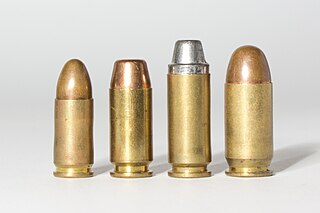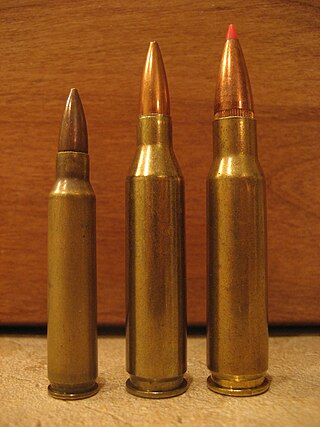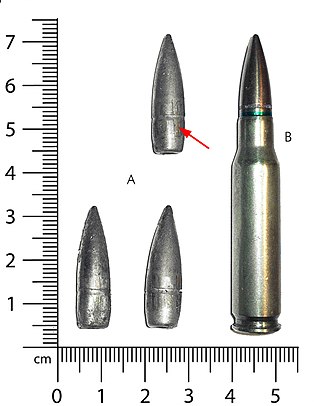
The 5.56×45mm NATO is a rimless bottlenecked intermediate cartridge family developed in the late 1970s in Belgium by FN Herstal. It consists of the SS109, L110, and SS111 cartridges. On 28 October 1980, under STANAG 4172, it was standardized as the second standard service rifle cartridge for NATO forces as well as many non-NATO countries. Though they are not entirely identical, the 5.56×45mm NATO cartridge family was derived from and is dimensionally similar to the .223 Remington cartridge designed by Remington Arms in the early 1960s.

A bullet is a kinetic projectile, a component of firearm ammunition that is shot from a gun barrel. They are made of a variety of materials, such as copper, lead, steel, polymer, rubber and even wax; and are made in various shapes and constructions, including specialized functions such as hunting, target shooting, training, and combat. Bullets are often tapered, making them more aerodynamic. Bullet size is expressed by weight and diameter in both imperial and metric measurement systems. Bullets do not normally contain explosives but strike or damage the intended target by transferring kinetic energy upon impact and penetration.

A cartridge, also known as a round, is a type of pre-assembled firearm ammunition packaging a projectile, a propellant substance and an ignition device (primer) within a metallic, paper, or plastic case that is precisely made to fit within the barrel chamber of a breechloading gun, for convenient transportation and handling during shooting. Although in popular usage the term "bullet" is often used to refer to a complete cartridge, the correct usage only refers to the projectile.

This is a table of selected pistol/submachine gun and rifle/machine gun cartridges by common name. Data values are the highest found for the cartridge, and might not occur in the same load.

The 9×19mm Parabellum is a rimless, centerfire, tapered firearms cartridge.

The .22 Long Rifle, also known as the .22LR or 5.6×15mmR, is a long-established variety of .22 caliber rimfire ammunition originating from the United States. It is used in a wide range of firearms including rifles, pistols, revolvers, and submachine guns.

The .44-40 Winchester, also known as .44 Winchester, .44 WCF, and .44 Largo, was introduced in 1873 by the Winchester Repeating Arms Company. It was the first metallic centerfire cartridge manufactured by Winchester, and was promoted as the standard chambering for the new Winchester Model 1873 rifle. As both a rifle and a handgun caliber, the cartridge soon became widely popular, so much so that the Winchester Model 1873 rifle became known as "The gun that won the West."

Nosler, Inc. is an American manufacturing company based in Bend, Oregon, known for producing ammunition and handloading components and specializing in high-performance hollow-point and soft-point hunting bullets. The current companies also include subsidiaries Nosler Custom and Nosler Reloading. Nosler's contributions to shooting sports include both polymer-tipped bullet designs and new manufacturing techniques used in their production.

The .243 Winchester (6×52mm) is a popular sporting rifle cartridge. Developed as a versatile short action cartridge to hunt both medium game and small game alike, it "took whitetail hunting by storm" when introduced in 1955, and remains one of the most popular whitetail deer cartridges. It is also commonly used for harvesting blacktail deer, pronghorns and mule deer with heavier rounds, and is equally suited to varmint hunting with lighter rounds. The .243 is based on a necked down .308 Winchester, introduced only three years earlier. Expanding monolithic copper bullets of approximately 80 to 85 grains or traditional lead rounds of 90 to 105 grains with controlled expansion designs are best suited for hunting medium game, while lighter rounds are intended for varmints.

Armor-piercing bullets for rifle and handgun cartridges are designed to penetrate ballistic armor and protective shields intended to stop or deflect conventional bullets. Although bullet design is an important factor with regard to armor penetration, the ability of any given projectile to penetrate ballistic armor increases with increasing velocity. Rifle cartridges typically discharge bullets at higher muzzle velocity than handgun cartridges due to larger propellant charge. However, even the same cartridge fired from a rifle will, in almost all common cases, have a higher velocity than when fired from a handgun. This is due to the longer period of acceleration available within the longer gun barrel of rifles, which allow adequate time for the propellant to fully ignite before the projectile exits the barrel. For this reason, bullets fired from rifles may be more capable of piercing armor than similar or identical bullets fired from handguns. In addition, a small-caliber bullet has higher sectional density than a larger-caliber bullet of the same weight, and thus is more capable of defeating body armor.

Federal Premium Ammunition is a wholly-owned subsidiary of Vista Outdoor, located in Anoka, Minnesota. With a workforce of nearly 1,500, Federal manufactures shotshell, centerfire, and rimfire ammunition and components.

CCI, based in Lewiston, Idaho, manufactures rimfire ammunition, centerfire handgun ammunition, and primers for reloaders and industrial ammunition production. CCI made the first mini-mag rimfire ammunition in 1963, and in 1975 developed the Stinger, a high velocity .22 Long Rifle product. Today, CCI makes a wide range of rimfire and snake shot ammunition.
Lee E. Jurras was an American firearm cartridge designer, known for creation of the Super Vel line of cartridges, and groundbreaking developments in hollow-point ammunition.
The .500 A-Square is a belted, bottleneck rifle cartridge, developed by Arthur Alphin in 1976. The cartridge is based on the .460 Weatherby Magnum necked up to accept the .510 in (13.0 mm) bullet; the same as the .50 BMG cartridge. This was Col. Alphin's first commercial sporting cartridge and was designed in “response to some severe problems experienced with the .458 Winchester on safari in Mozambique.”

The 7.62×51mm NATO is a rimless, bottlenecked rifle cartridge. It is a standard for small arms among NATO countries.

Green bullet, green ammunition or green ammo are nicknames for a United States Department of Defense program to eliminate the use of hazardous materials from small arms ammunition and from small arms ammunition manufacturing. Initial objectives were elimination of ozone-depleting substances, volatile organic compounds, and heavy metals from primers and projectiles. These materials were perceived as causing difficulties through the entire life cycle of ammunition. The materials generated hazardous wastes and emissions at manufacturing facilities and use of ammunition caused contamination at shooting ranges. Potential health hazards made demilitarization and disposal of unused ammunition difficult and expensive.

International Association for the Protection of Civilian Arms Rights (IAPCAR) is an association of gun rights organizations, with over 29 member organizations.
The Cuomo Mag is a 3D printed AR-15 magazine named after the Governor of New York, Andrew Cuomo, who signed the NY SAFE Act into law banning magazines capable of holding more than 10 rounds of ammunition. It was created by Defense Distributed and made public around January 2013

Monolithic bullets are bullets constructed from a one solid material, usually metal, and do not have multiple components. Unlike jacketed hollow point bullets (JHP), monolithic bullets do not have a jacket, cup, core, or tip. They are instead a solid material, typically copper or a copper-zinc brass alloy, although historically any bullet made of a single type of metal can be referred to as a monolithic bullet. Monolithic bullets depart quite dramatically from the better known lead- or jacketed bullet, and offer a more environmentally friendly alternative to the toxicity associated with lead bullets. As a result of increasing environmental concerns over the toxicity levels found in lead-based bullets, some areas in the United States of America have banned the use of lead bullets for hunting purposes. This increasing awareness of the dangers of lead bullets has led to the development of the modern monolithic bullet, which now provides a viable and accurate alternative to the use of lead for shooting.
















